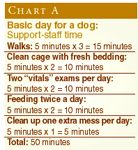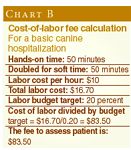Set fees objectively, with simple algebra
Quicksand fees will sink a practice.
Quicksand fees will sink a practice.
Those are fees determined by watching and adopting other practices' fees to set our own.
It is quite simple to set objective fees by basing them on our individual in-house costs.
The reality is that each practice is unique.
Considering that there are at least 18 different small-animal practice niches, we need a clear, simple system to assess our specific situation in setting fees.
Many practitioners get a bit defensive when discussing fees with clients, staff and others.
That's often because we may not fully realize how we arrived at our fee schedule. If we were secure in that knowledge, we might simply say, "Yes, the care is expensive."
We know that veterinary practices over time have become less profitable in the face of rising expenses.
Expenses may be categorized into four basic groups:
Fixed expenses (rent and other general), variable expenses (drugs, supplies, support labor), salaries and profit groups.
Veterinary salaries have risen, largely at the expense of cannibalized net profits.
Rising fixed, variable and veterinary labor expenses have cut net profit, making practices less valuable.
These realities should tell us that we must understand how to set fees that will keep the practice healthy.
Income sources
Income is gathered from three groups: outpatient services, inpatient services and ancillary services (boarding, grooming and OTC sales).
(For this discussion, we will not consider ancillary services.)
In most practices, outpatient and inpatient services are generated at a 70:30 ratio.
Outpatient services generate 30 percent of the overhead and inpatient services 70 percent.
For clarification, inpatient areas include patient wards, surgical set-up, in-house laboratory set-up, radiology, the treatment room and dental set-up.
Therefore, we have 30 percent of the overhead generating 70 percent of the revenue, with the inpatient overhead of 70 percent generating 30 percent of the overhead.
This 70:30 ratio is a veterinary- medicine and business-paradigm flaw that is driving changes within the profession while limiting the profession's advancement.
We cannot expect the profession to address this dilemma, but many individuals are doing so.
With the 70:30 and 30:70 numbers, we can look to practices that are largely wellness practices without the inpatient zones. We see that these niches are doing quite nicely.
In my travels to places like the Netherlands, where most practices are outpatient-based and with limited inpatient capabilities, I see practices that are quite profitable.
Successful private practices start with excellent staffs. That probably is more important to inpatient services than outpatient services.
So why does the inpatient zone generate only 30 percent? Three basic reasons:
Not enough staff, too few offered inpatient services and inadequate fees.
Inadequate inpatient fees
If inpatient services are provided at cost or below cost, the practice cannot afford to offer them.
Many veterinary hospitals function this way, and this hurts their profits.
Most practice managers agree that income is linear with support staff. Double the support staff leads to double income, more or less.
Yet many still consider labor a fixed expense. Support-staff labor is linear and thus is a variable expense.
For the fee schedule to accurately reflect the expense relative to the income, support staff hands-on duties must be treated as a variable.
Because support staff is linear, the labor cost can be popped into an algebra equation.
Let us consider a dog in the hospital for a day and its basic daily needs for 24 hours. (Chart A, p. 49)
The cage needs to be cleaned, walks need to be taken, vitals taken twice a day, plus there are feedings and cage clean-up.

Chart A
For this discussion, let's figure $10 per hour pay for support staff.
Thus 50 minutes of hands-on time at 0.167 cents per minute is $8.33 of support-staff labor — just for the basics.
Before we set the fees we must consider "soft time."
That includes answering the telephone, setting appointments, checking clients in and out, cleaning floors and windows, infrastructure duties such as payroll, maintenance issues, inventory management, consumer services and...the list is endless.
Our research has demonstrated that in most situations one hour of soft time equals about one hour of hands-on time.
With this knowledge we can set up a fee for a basic day for a dog: 50 minutes x 2 = 100 minutes.
100 minutes at 0.167 cents per minute = $16.70.
The simple labor formula is cost of labor divided by the labor budget number.
We will use labor cost at 20 percent. Thus, $16.70 divided by 0.20 = $83.50.
The fee for a 24-hour stay should be $83.50 if labor cost is $10 (See Chart B).
To this we would add professional fees, medication fees, specific nursing duties and diagnostic services.
Our surveys show most practices charge about 50 percent of what is needed to sustain daily inpatient care.
If the average cost of labor is $20, then the resultant fee would double to $167.
When the cost of labor in our practices is a known, we can use that for fee setting.
While it is not true that the highest paid veterinarians always offer the best services, it is likely true that the highest-paid support staff provide better services than lower-paid staffs, making it reasonable to charge fees according to their time.

Chart B
Many practices subsidize inpatient services with outpatient services or they just refer them or offer only a limited array of services.
The result?
Consumers now "fracture" their dollars at several clinics to get services (spay clinics, vaccine clinics, eye specialists and orthopedics), thus adding more financial stress to the system.
Many practices could offer more inpatient services if they charged appropriately, using the cost of labor to provide the services and set fees.
With a limited array of inpatient services and veterinarians on commission pay, there is a disincentive to learn more about labor-intensive inpatient services.
The failure to charge the fair fee for inpatient services becomes a disincentive to provide them.
Take these steps to set fees
- Accept that your overhead is different and commit to creating your own fee schedule.
- List the top 10 inpatient services, time them and then create your fees using the cost of labor and algebra.
- Use the highest-paid person to calculate the labor cost.
- Set labor costs at 20 percent.
- Begin a new life with inpatient services.
- Smile, and get defensive no more.
Next month, we'll discuss pricing strategies.
Dr. Riegger, Dipl. ABVP, is the chief medical officer at Northwest Animal Clinic Hospital and Specialty Practice. Contact him by telephone or fax (505) 898-0407, Riegger@aol.com, or www.northwestanimalclinic.com. Order his books "Management for Results" and "More Management for Results" by calling (505) 898-1491.